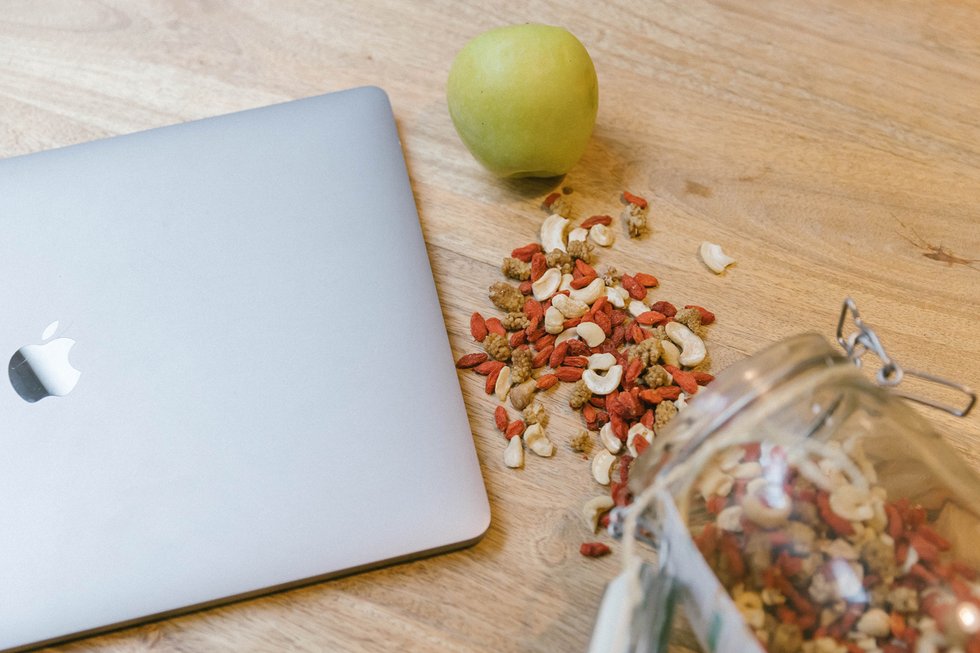Food for Thought: Five Ways to Eat More Healthily at Work and Eliminate Stress
03 avr. 2019
5min

AU
Twenty percent. That’s the decrease in productivity in companies because of poor eating habits, according to the International Labor Office. In a world where everything moves at an ever-increasing pace and workdays are jam-packed, how can you find time to eat in way that helps you achieve more?
Nutrition at the heart of media-based companies and corporate culture
Why is proper nutrition an essential issue for businesses to address? Because we spend 70% of our time at work. So, if we are going to set up some guidelines for ourselves, the best place to start is at work.
“Scientists believe we have a second brain in our gut. Several million neurons control vital systems, such as digestion, and they are connected to our central nervous system. These two brains communicate and exchange information. Consequently, healthy or poor nutrition can have an impact on our mood, feelings, and, eventually, our overall well-being. Eating more healthily improves our condition, both physically and psychologically, and allows us to access the best part of our skills. At work, we talk about better productivity, but more than anything, [eating healthily] is a way to be happier on a daily basis,” says Nicolas Pacary, director of corporate sales at the French pressed-juice-delivery company Yumi.
“Eating more healthily improves our condition, both physically and psychologically, and allows us to access the best part of our skills”—Nicolas Pacary, Yumi
If we eat well, our body transforms our meals into energy, whereas eating poorly can result in fatigue, a reduction in mental efficiency, irritability, a lack of energy, and more stress. Sabine Monnoyeur, a naturopath who works with Yumi, says, “We can even eliminate stress through how we eat.”
“Nevertheless, trying to eat well can also result in a host of new problems, such as not having enough time, practicality, and taste. Taking into account the time we all spend at work, businesses are at the core of the issue. They have a crucial role to play and should therefore be looking for ways to respond to their employees’ needs in the best way possible, not only for the employees’ well-being but also for the company’s prosperity,” says Pacary.
But even before your employer implements the required measures, here are a few recommendations you can follow to “eat for productivity.”
Five recommendations for eating to increase productivity
1.Favor certain types of food
“The goal should not be just to eat, but to actively choose healthy and delicious foods that can be digested easily,” says Pacary. “We should prioritize foods that take care of our intestinal flora, and we should reduce ingestion of ‘rapid-absorption’ carbohydrates. What does this really mean? Vegetables, in all forms, are your best ally. Their numerous benefits include ease of digestion and being a great source of vitamins. On the other hand, cakes, ice cream, and soft drinks will slow you down because they lead to fatigue and longer-term health issues. Also, the natural sugars found in fruits, vegetables, and cereals are really enough.”
Monnoyeur offers 11 nutritional tips for improving your daily diet:
1. Seventy percent of what you eat should be fruit- and vegetable-based—and focus on filling your lunchbox with organic, in-season, locally sourced produce.
2. Always eat a serving of raw vegetables, either chopped up or as a juice.
3. Avoid “empty foods” such as coffee, soft drinks, hot chocolate, and tea, even if it becomes really tempting when you’re in the office.
4. Where possible, avoid processed foods and eat meals that haven’t needed a lot of preparation—the rawer your food, the better.
5. Eat fruit between meals.
6. Limit your gluten intake (avoid eating sandwiches on the run between meetings).
7. Vary your sources of protein.
8. Focus on foods that contain healthy fats (such as unsaturated fats, omega-3).
9. Go for goat’s or sheep’s milk when you’re choosing your milk-based foods.
10. Chew your food well and, yes, take your time.
11. Avoid drinking while you’re eating, but do keep some water on your desk so you don’t forget to drink during the day.
By following these steps, your productivity will be at its best.
A good way to remember all of this is by following the 80/20 rule. “Eat a balanced and sensible diet 80% of the time. The rest of the time, enjoy more indulgent foods such as burgers, desserts, and cheese,” says Monnoyeur.
“Eat a balanced and sensible diet 80% of the time. The rest of the time, enjoy more indulgent foods”—Sabine Monnoyeur, naturopath
2. Pay attention to how long you keep food
“As soon as we conserve food, it loses its vitamins,” says Claude Aubert, an agricultural engineer and the author of L’art de cuisiner sain (The Art of Healthy Cooking). “If you cook a cabbage—one of the richest sources of vitamin C—you destroy 10% to 20% of its vitamins after a few minutes.” Soups do not fall into this category, since most of what is lost is retained in the cooking water. Another example is lettuce, which loses one-third of its vitamins after a few days of refrigeration. Therefore, the key is to eat fresh foods. So as often as possible, prepare a lunchbox at home to bring to work the next day.
3. Don’t look at your screen while you’re eating
We’re all familiar with short lunches taken at our desks while reading the emails we didn’t have time to look at in the morning. We think we’re saving time, but we haven’t yet figured out that this habit negatively affects our digestion. “Our brain doesn’t understand what’s happening if we eat in front of a computer or television,” says Angélique Houlbert, a nutritionist and the author of several books including La meilleure façon de manger (The Best Way to Eat) and Stress, les solutions naturelles (Stress: The Natural Solutions). “What happens is the feeling of being full doesn’t occur immediately and we end up eating more.” Going back to work feeling like you’ve eaten too much is not the solution. Going outside or having lunch with coworkers, even if it’s quick, is better for your body and digestion.
“Eating in front of a computer or television doesn’t allow your brain to understand what’s happening. What happens is the feeling of being full doesn’t occur immediately and we end up eating more”—Angélique Houlbert, nutritionist and author
4. Change your work pace
When you have the time and can take a proper break at lunch, have a power nap one day, if possible, and go to the gym the next. Also, try to make the effort to be more organized in your work. For example, limit distractions (such as screens). If you want to see real benefits from healthy eating, you need to adopt healthy living in all areas of your life, but often it is not easy to change your habits by yourself. If you don’t know where to start, make an appointment to see a professional, such as a life coach or nutritionist, to help you set your goals.
5. Take the lead by proposing your tribe “eats productively” together
Suggest you and your colleagues all chip in together to organize deliveries of healthy food to the workplace, and see if it’s possible to improve the communal spaces for preparing and eating food. Be innovative and propose new solutions to your superiors. Find companies that can make daily deliveries of healthy items, such as cold-pressed, fresh, organic vegetable and fruit juices, shots of ginger (instead of coffee), and fresh, vitamin-packed juice bars, and run cookery and naturopathic workshops. Enabling employees to eat healthily during the workday must be a key goal of the company in a fun and tasty way.
Good nutrition should be one of the top concerns for brands, media companies, and other businesses to address. It’s sometimes difficult to make the best food choices out of the multitude of recommendations, so put simply, just trust yourself. If you listen to your body, it’s safe to say that you will make the best choices for eating healthily and doubling your productivity. So go for it!
Translated by Mary Waggoner-Moritz
Photo: Welcome to the Jungle
Follow Welcome to the Jungle on Facebook on LinkedIn and on Instagram and subscribe to our newsletter to get our latest articles every day!

Inspirez-vous davantage sur : Santé

Navigating your career while managing chronic illness
Struggling to juggle work and chronic illness? Learn how to create a supportive career path and find solutions.
24 déc. 2024

The best equipment to help you get exercise without leaving your desk
A sedentary lifestyle can lead to serious health problems. So, how can you stay fit while still at your desk?
09 nov. 2023

Glued to your desk all day? Try these discreet exercises
Laptop-based work can mean freedom and comfort, but a sedentary lifestyle also brings a host of health risks...
18 oct. 2023

How the world of work is getting better for veterinarians
Though typically not considered a dangerous profession, veterinary services rank among the highest industries for non-fatal injuries
04 oct. 2023

The dynamic benefits of walking meetings
As our jobs become more flexible, workers are finding new ways to improve their mental and physical health
03 oct. 2023
La newsletter qui fait le taf
Envie de ne louper aucun de nos articles ? Une fois par semaine, des histoires, des jobs et des conseils dans votre boite mail.

Vous êtes à la recherche d’une nouvelle opportunité ?
Plus de 200 000 candidats ont trouvé un emploi sur Welcome to the Jungle.
Explorer les jobs